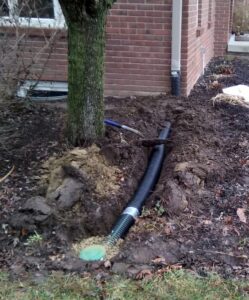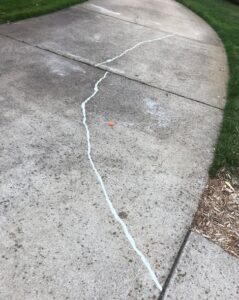Is Your Driveway Sinking? Explore Causes & Solutions

Once upon a time, your driveway was a freshly poured, smooth, and even surface. As the years have passed, that has changed. Your drive has endured changing seasons, extreme temperatures, erosion, and of course- the wear and tear of vehicles.
All of these variables have an impact on your property as a whole, and the driveway shows the damage. Are you thinking about replacing your sunken driveway? This is an expensive and messy project that can disrupt your whole neighborhood. What if it’s possible to avoid that situation, and lift the driveway back into position?
Acculevel has been repairing concrete slabs since 1996. We’re a family-owned and operated company, serving Indiana and parts of the surrounding states. We’ve repaired driveways, garage floors, patios, and other concrete slabs for thousands of homeowners throughout our service area. We want to give you the details about concrete lifting you need, so you can make the best decision for you and your home.
In this article, we’re going to explore why a driveway cracks and sinks. We’ll explain how concrete leveling works, and give you an overview of the costs of repair versus replacement.
We’ll schedule an appointment for you with one of our knowledgeable and experienced project advisors. They’ll meet with you, learn more about your project and plans, then thoroughly evaluate your home. Once the assessment is complete, they’ll review their findings and provide you with a whole-home solution to guarantee your project is a success.

Both of these photos were taken by Acculevel employees. On the left is a driveway before repair; on the right is the same section after crack fill and slabjacking.
Why Is Your Driveway Sinking?
Most driveways sink because of natural causes; rain, seasonal changes, and fluctuating soil conditions cause a lot of damage.
Erosion Plays a Major Part
Rain can have an immediate negative impact on your driveway. The water can wash out the soil underneath it, especially if your guttering downspouts are emptying next to -or are aimed at- your driveway. At Acculevel, we recommend that downspouts are directed at least 10 feet away from your home’s foundation. Ideally, this drainage point would also be placed in a location in your yard where it won’t impact your patio, driveway, decking, etc.
If your downspouts don’t meet these criteria, you should invest in downspout extensions. Don’t underestimate the significance of water damage to your house and property. To learn more about why downspout extensions are important, follow this link. The article features a detailed tutorial, if you are a DIY homeowner.

This photo was taken by an Acculevel crew member, as they installed a downspout extension at a customer’s home.
Issues With The Soil Beneath Your Driveway
Erosion can cause the concrete slab to sink, but sometimes the site preparation or soil type is an issue. When your home was built, the topsoil was disturbed by the construction process. Before a driveway can be installed correctly, the ground needs to be compacted. This means the builder will smooth and re-grade the earth to create a dense and level surface that will minimize the distance a driveway can settle. for the concrete to be poured.
If the ground is not prepared accurately, the driveway will have pockets of soft dirt that can easily erode. The type of soil on the property is also a factor; granular soil (with lots of sand or rock particles) erodes more rapidly than more expansive or clay-based soils.

This photo of a cracked and uneven drive was taken by an Acculevel project advisor during a routine in-home evaluation.
When the soil beneath an existing driveway moves, it can create gaps where the concrete is not fully supported. Heavy vehicles driving over poorly-supported concrete can create cracks. And once a crack forms, erosion only makes it worse.
Temperature fluctuations also contribute to issues beneath the driveway. A common saying in our area is, “Don’t like the weather? Wait an hour.” It can snow any time between October and May, and temperature changes of 20+ degrees are typical. As the ground freezes, thaws, and freezes again, this changing pressure can create damaging frost heaves.

This photo was taken at the same home by an Acculevel team member after slabjacking and crack repair.
What Is a Frost Heave, and How Does It Affect A Concrete Driveway?
We just mentioned the freeze-and-thaw cycle that we experience in the colder months of the year. This creates the circumstances that form a frost heave. When water freezes, it expands, forcing things around it to move (heave) upwards.
Since concrete is not a flexible material, it doesn’t react well to the ground shifting beneath it. This is another way cracks can form in your driveway.
Whether erosion removes support under the slab or frost heaves push one side up, unlevel soil causes the concrete to crack.
How Do You Repair A Sinking Driveway?
There are two options for repairing a sunken driveway: tear it out and replace it, or use a concrete leveling method like slabjacking.
Slabjacking Can Lift Sunken Driveways
If your concrete driveway is cracked and sinking, concrete lifting can be a great repair option. Concrete lifting is accomplished by drilling holes through the concrete and injecting a fill material into the gaps created by erosion and weather.
Slabjacking uses a polyurethane fill material that is mixed during the injection process. As the two components combine, they activate and “foam up.” This foam expands, then solidifies into a lightweight, nontoxic substance that adheres to the concrete and the soil below it. This foam does not erode or break down with seasonal variations. It also sets up completely within minutes, allowing you to drive and park on the surface within a few hours of the repair.
Slabjacking is less expensive than pouring new concrete, and the process causes minimal mess and disruption to your home and neighborhood. Acculevel has work trucks designed specifically for this process, and the injection hoses are up to 250 feet long. This means our crew can park on the street and run the hoses directly up the driveway without damaging your yard.
Once the driveway is lifted back into place, any cracks in the concrete can be filled with epoxy. This restores your drive to a smooth and even driving surface. The only drawback is it will look like repaired concrete, unlike the more aesthetically pleasing brand new concrete.
Replacing a Sinking Driveway Is An Option
Of course, you can always have the existing driveway torn out and replaced. This will eventually result in the best possible curb appeal. But having a new driveway poured is a much slower and more complicated process than slabjacking.
Your sunken concrete needs to be broken up, usually by a jack hammer. Those pieces are hauled away, the soil is manually leveled and compacted, then a new form for the driveway is built. While this construction is happening, you are parking on the street, and workers are walking through your yard.
Once the new concrete is poured, you have to wait several weeks for it to cure. As you’re still parking on the street, this could be a frustrating task that inconveniences you and your neighbors.
In addition to the disruption to your daily routine, cost is another factor. Depending on the size of your drive, replacing the concrete can cost double (or even triple) the price of slabjacking.
Is Slabjacking The Right Option For Your Home?
What happens next is up to you! If the answer to that question is yes, find an experienced specialty company that provides slabjacking, and make an appointment. Please protect yourself, and verify the company is reputable, insured, and accredited by the Better Business Bureau.
If you live in Indiana or the surrounding states, contact us at Acculevel. We will send one of our experienced project advisors to meet with you, evaluate your home, and recommend the best course of action for you. We provide free estimates, and have a 4.9 (out of 5) rating with the BBB.
Not ready for an in-home estimate?
Want more information? We have additional resources for you!
Want to know more about the differences between mudjacking and slabjacking? This article provides a side by side comparison of the two methods.
There are some instances where slabjacking is not a good fit. We’ve put together an illustrated guide that explains when slabjacking will not work, and why.
